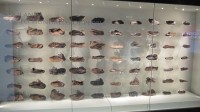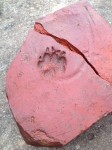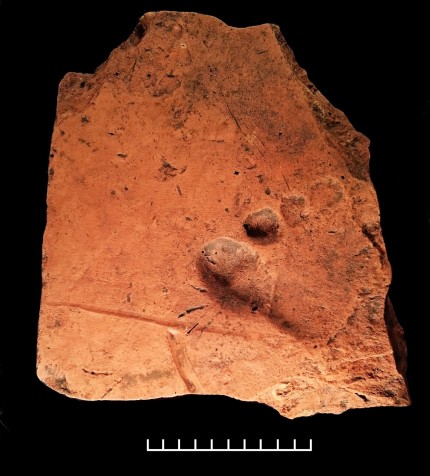 The Roman fort of Vindolanda in Northumberland one mile south of Hadrian’s Wall, the northernmost boundary of the Roman Empire, is renowned for the great number of organic artifacts preserved for 2,000 years in its anaerobic soil. The Romans built nine forts on the site, each time demolishing buildings and covering them with clay and turf. This capped the old layers and ensured the wood, leather, textiles and other organic remains trapped in them would survive in exquisite condition. The hundreds of wooden writing tablets from the late 1st, early 2nd century A.D. were voted Britain’s top treasure by British Museum curators for a 2003 BBC program, propelled by their immense social historical significance past the likes of the Sutton Hoo ship burial and the Lewis Chessmen. The tablets were found only in one section of the fort. Leather shoes, on the other hand, have turned up all over the site. There are more than 6,000 of them, many perfectly intact, forming the major part of the largest collection of Roman leather in the world. The Vindolanda Museum has a wall of ancient shoes on display.
The Roman fort of Vindolanda in Northumberland one mile south of Hadrian’s Wall, the northernmost boundary of the Roman Empire, is renowned for the great number of organic artifacts preserved for 2,000 years in its anaerobic soil. The Romans built nine forts on the site, each time demolishing buildings and covering them with clay and turf. This capped the old layers and ensured the wood, leather, textiles and other organic remains trapped in them would survive in exquisite condition. The hundreds of wooden writing tablets from the late 1st, early 2nd century A.D. were voted Britain’s top treasure by British Museum curators for a 2003 BBC program, propelled by their immense social historical significance past the likes of the Sutton Hoo ship burial and the Lewis Chessmen. The tablets were found only in one section of the fort. Leather shoes, on the other hand, have turned up all over the site. There are more than 6,000 of them, many perfectly intact, forming the major part of the largest collection of Roman leather in the world. The Vindolanda Museum has a wall of ancient shoes on display.
 What it hasn’t had until now was a print of one of the feet those shoes once shod. Mel Benard, a Classical Studies student at the University of Western Ontario’s Vindolanda Field School who has been volunteering this digging season, unearthed a clay tile bearing the very clear partial imprint of a human foot on its surface. It was June 25th and this was the first artifact she found. The print is of a the ball and four toes of a small right foot probably belonging to an adolescent. The youth traipsed across the tile while it was drying in around 160-180 A.D.
What it hasn’t had until now was a print of one of the feet those shoes once shod. Mel Benard, a Classical Studies student at the University of Western Ontario’s Vindolanda Field School who has been volunteering this digging season, unearthed a clay tile bearing the very clear partial imprint of a human foot on its surface. It was June 25th and this was the first artifact she found. The print is of a the ball and four toes of a small right foot probably belonging to an adolescent. The youth traipsed across the tile while it was drying in around 160-180 A.D.
 Animal prints have been found embedded in tiles fairly often at the fort. In fact, the Vindolanda Field School team unearthed a tile with cat or dog print (I vote dog; those big toe pads and claws look far more doggy than catty) just two days before Benard’s discovery. Human animals aren’t as likely to run across wet tiles and incur the dreadful wrath of the tile-maker.
Animal prints have been found embedded in tiles fairly often at the fort. In fact, the Vindolanda Field School team unearthed a tile with cat or dog print (I vote dog; those big toe pads and claws look far more doggy than catty) just two days before Benard’s discovery. Human animals aren’t as likely to run across wet tiles and incur the dreadful wrath of the tile-maker.
“This find is really extraordinary”, explains Co-Director of the University Field School, Dr Elizabeth Greene, “it brings full circle the story that Vindolanda has to tell. The thousands of leather shoes from this site (over 6,000) give us a unique perspective on the people who lived at Vindolanda but this footprint highlights even more that archaeology has the potential to illuminate the lives of otherwise voiceless individuals from antiquity”.
Once the tile has been conserved, it will go on display in the Vindolanda Museum, a rare honor that Mel Benard and her teammates feel keenly. “Finding something which would be considered special enough to go on display in the Vindolanda museum with all the other amazing artefacts was one of the ambitions of the Field School, we are all absolutely thrilled.”

You can and should follow the blog of the Vindolanda Field School here. They post recaps of their excavations almost daily and include some great photographs. I hadn’t heard of iron pan, a road-building technique that combines characterstic Roman ingenuity and lack of squeamishness, until I read about it in this post.
When I was troweling the road I noticed a lot of iron in the ground and bone coming out from it. Andy, director of excavations told me it was called iron pan. This was the reason why the road was held together so well. Iron pan is a process that was caused by the Romans pouring animal blood and bones on their roads. This causes iron to build up between the cracks and create a kind of metallic mortar.
I’m officially obsessed.
Hello, Regarding the animal print, the information may not be the most significant, and is probably already known, but I would put my chips on the paw print being that os an early Malinois, or a similar breed dog. The Romans were known to outfit them in armor and send them into battle along with their soldiers. I believe the Greek armies had this same type of practice with this pup. From what I understand, this breed is still used in modern warfare deployments, of course being nose and snout with the Belgium conventional forces, but also trained to be assets to many countries special operational forces, such as the US Rangers and Navy Seals, the Israeli special forces, and are even used by the US Secret Service in their grounds patrols of the US White House.
Thank you for reading
-Tom
I do enjoy the lessons that archaeology teaches. But on a different level, I also enjoy the colemanballs that archaeologists so often spout. “this footprint highlights even more that archaeology has the potential to illuminate the lives of otherwise voiceless individuals from antiquity” is a classic of the genre.
Definitely a dog, as cats draw in their claws when walking (e.g. over fresh tiles) and their claws look just different compared to canine ones. When we were taking a tray full of freshly made cookies out from the oven ages ago, one of those cookies featured a perfect paw imprint without any claws, and the only suspect had been a cat.
That human foot imprint, however, presented here -also depending on its size- could possibly be that of a toddler, couldn’t it ? – Truly, an impressive collection of ‘caligae’, btw !
Metallic mortar from blood and bones? I’m calling techno-bs.
I’m not sold on this concept myself.
The dog print appears to have what looks like the heel mark of a shoe around it.
I didn’t know about the bones but it’s actually well documented that the Romans used blood when mixing cement. One of the reasons their concoction has stood the test of time.
I’ve heard about the Romans using blood in cement as well.
The aqueducts, the sanitation, the roads, the irrigation, the public baths and the blood in the cement.
Yes, the Romans may have added blood and bone to cement and pavement, but these did not produce the iron or metallic mortar found in the pavement described here.
Pity that it would be too difficult to determine the days those imprinted tiles were made, relative to each other. It would be fun to think that the young human was chasing a beloved and playful dog off of the drying work… the apparent change in direction between front paw and back paw print would support that.